 PRISON
(1988) Blu-ray/DVD combo
PRISON
(1988) Blu-ray/DVD comboDirector: Renny Harlin
Scream Factory/Shout! Factory
 PRISON
(1988) Blu-ray/DVD combo
PRISON
(1988) Blu-ray/DVD comboShout! Factory’s goes behind bars with Renny Harlin’s American directorial debut PRISON, one of Empire Pictures’ long-unavailable productions finally available on Blu-ray (and DVD) as part of the “Scream Factory” line.
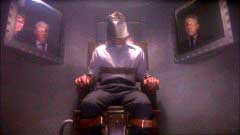
When funding falls through for the construction of a brand new prison, the only alternative is to reopen the Wyoming State Penitentiary in Rawlins (closed since 1968) against the objections of reform-minded board member Katherine Walker (Chelsea Field, DUST DEVIL). Walker is further displeased with the appointment of Ethan Sharpe (Lane Smith, NETWORK) as warden since he regards the purpose of a prison to isolate criminals from the public and therapy and trade skills training as “so much window dressing”. The prison is barely habitable, but Sharpe plans to have 300 inmates he is having bussed in to take care of the cleanup. An escape attempt by Rabbit (Tom Everett, LEATHERFACE: TEXAS CHAINSAW MASSACRE III) lands himself and reluctant passenger Hershey (Larry Flash Jenkins, FLETCH) in the hole and the loss of privileges for the other inmates. Sharpe takes a particular disliking to “man of few words” Burke (Viggo Mortensen, THE REFLECTING SKIN) and instructs him and Santeria-practicing inmate Sandor (André De Shields, EXTREME MEASURES) to break through the wall to the execution chamber, which unleashes a malevolent force that makes little distinction between the inmates and the guards as a series of grisly “accidents” start claiming lives. Despite evidence to the contrary, Sharpe looks for a motive and culprit among the living inmates; but the reason for the deaths may lie in the prison’s past (in particular, the execution of an inmate whose specter haunts the warden’s sleep).
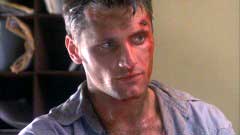 In
the late 1970s, HALLOWEEN producer Irwin Yablans’ Compass International
Pictures distributed Charles Band’s early pictures like TOURIST TRAP and
THE DAY TIME ENDED; however, in the 1980s Yablans and his brother/partner were
in the employ of Empire. Having felt prison was one of the few environments
left unexploited for a horror film, Yablans came up with an outline for “Horror
in the Big House” which he describes – in the disc’s retrospective
documentary – as “HALLOWEEN in prison”. Writer C. Courtney
Joyner (THE OFFSPRING) – for who PRISON was the first of several writing
jobs for Band, including entries in the PUPPET MASTER and TRANCERS series –
felt that the idea of a knife-wielding killer stalking prisoners would not work
since everyone has a shiv in prison; so he reworked it as a ghost story. Joyner
describes his take on it as “POLTERGEIST goes to jail” but the finished
film owes more to NIGHTMARE ON ELM STREET with a bit of THE KEEP which surely
must have been an influence on the sequence where Burke and Sandor breach the
execution chamber’s wall. The former film comparison is particularly fitting
since director Renny Harlin – making his American film directorial debut
here – would next direct A NIGHTMARE ON ELM STREET 4: THE DREAM MASTER.
Mac Ahlberg (HELL NIGHT) – who died last October – had already ventured
behind bars not too long ago with the seminal women-in-prison favorite CHAINED
HEAT, but PRISON’s supernatural premise and derelict prison location afforded
the cinematographer greater opportunities to exploit his lighting bag of tricks.
Richard Band’s and Christopher Stone’s score is sparse but unsettling,
often coming in the aftermath of the film’s scares like an echo. The make-up
effects are the work of Empire Pictures standby John Carl Buechler (TROLL) and
his Mechanical and Makeup Imageries crew, with stunt coordinator Kane Hodder
donning the first of several Buechler make-up creations (which got him the role
of Jason Voorhees in the Buechler-directed FRIDAY THE 13TH PART VII: THE NEW
BLOOD).
In
the late 1970s, HALLOWEEN producer Irwin Yablans’ Compass International
Pictures distributed Charles Band’s early pictures like TOURIST TRAP and
THE DAY TIME ENDED; however, in the 1980s Yablans and his brother/partner were
in the employ of Empire. Having felt prison was one of the few environments
left unexploited for a horror film, Yablans came up with an outline for “Horror
in the Big House” which he describes – in the disc’s retrospective
documentary – as “HALLOWEEN in prison”. Writer C. Courtney
Joyner (THE OFFSPRING) – for who PRISON was the first of several writing
jobs for Band, including entries in the PUPPET MASTER and TRANCERS series –
felt that the idea of a knife-wielding killer stalking prisoners would not work
since everyone has a shiv in prison; so he reworked it as a ghost story. Joyner
describes his take on it as “POLTERGEIST goes to jail” but the finished
film owes more to NIGHTMARE ON ELM STREET with a bit of THE KEEP which surely
must have been an influence on the sequence where Burke and Sandor breach the
execution chamber’s wall. The former film comparison is particularly fitting
since director Renny Harlin – making his American film directorial debut
here – would next direct A NIGHTMARE ON ELM STREET 4: THE DREAM MASTER.
Mac Ahlberg (HELL NIGHT) – who died last October – had already ventured
behind bars not too long ago with the seminal women-in-prison favorite CHAINED
HEAT, but PRISON’s supernatural premise and derelict prison location afforded
the cinematographer greater opportunities to exploit his lighting bag of tricks.
Richard Band’s and Christopher Stone’s score is sparse but unsettling,
often coming in the aftermath of the film’s scares like an echo. The make-up
effects are the work of Empire Pictures standby John Carl Buechler (TROLL) and
his Mechanical and Makeup Imageries crew, with stunt coordinator Kane Hodder
donning the first of several Buechler make-up creations (which got him the role
of Jason Voorhees in the Buechler-directed FRIDAY THE 13TH PART VII: THE NEW
BLOOD).
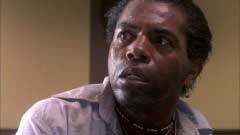
Plotwise, PRISON doesn’t give too much away too soon (there’s more to it than just a vengeful ghost of an executive criminal); but, in the end, it turns out to be one of those movies where you realize that it would be a significantly shorter film if the malevolent force had taken swift revenge. However senseless some of the killings are in terms of the plot, they are at least creative (two of them making use of some neat reverse motion photography). We can be thankful however that the film doesn’t condescend to SHINING-isms with Lane’s warden or Mortensen’s car thief, although that makes his character seem even more superfluous (even if you’ve easily guessed the final plot revelation expressed in the script but left out of the finished film). Similarly, Field’s heroine is so peripheral to the plot; supernaturally cluing her into what’s going on is a contrived way to involve her in the climax (and seems to run counter to the ghost’s intentions). The script does make the effort to establish some supporting inmate characters’ relationships apart from the main plot – including Burke’s wannabe buddy “Lasagna” (Ivan Kane, PLATOON), his towering cellmate “Tiny” (Tommy 'Tiny' Lister, EXTREME PREJUDICE), prison “operator” Rhino (Stephen E. Little) and his prison bitch Brian (Yablan’s son Mickey who also had a small role in HALLOWEEN) – but (likable as some of them are) their fates in the riot cutaways during the climax aren’t as meaningful as they were probably intended (only Burke’s “old timer” cellmate Cresus [Lincoln Kilpatrick, THE OMEGA MAN] is given more involvement with the main storyline and garners more audience sympathy than any of the other principals).
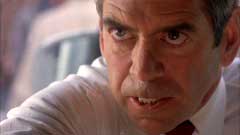 One
of Empire’s last productions, the film had a scant theatrical release
before hitting video through New World. Although just now making its way to
DVD and Blu-ray stateside – by way of Shout Factory’s licensing
deal with MGM – the film has been available on DVD abroad for several
years (although the recent Scandinavian DVD marked the first availability of
an anamorphic widescreen transfer). The HD master represented in this combo
package comes from a virtually unblemished source (I noticed only one instance
of damage in the form of a single white mark roughly seventy-five minutes into
the film). The Ultra Stereo is available as both a faithful 2.0 mix and a 5.1
upmix (both in DTS-MA on Blu-ray and Dolby Digital on DVD). The upmix (not a
remix) is perfectly enveloping, but the Ultra Stereo matrixed surround original
was fine to begin with. Optional English subtitles are also included, but they
only occasionally feature SDH notations.
One
of Empire’s last productions, the film had a scant theatrical release
before hitting video through New World. Although just now making its way to
DVD and Blu-ray stateside – by way of Shout Factory’s licensing
deal with MGM – the film has been available on DVD abroad for several
years (although the recent Scandinavian DVD marked the first availability of
an anamorphic widescreen transfer). The HD master represented in this combo
package comes from a virtually unblemished source (I noticed only one instance
of damage in the form of a single white mark roughly seventy-five minutes into
the film). The Ultra Stereo is available as both a faithful 2.0 mix and a 5.1
upmix (both in DTS-MA on Blu-ray and Dolby Digital on DVD). The upmix (not a
remix) is perfectly enveloping, but the Ultra Stereo matrixed surround original
was fine to begin with. Optional English subtitles are also included, but they
only occasionally feature SDH notations.
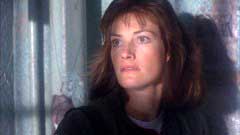
Renny Harlin goes solo for an audio commentary. He describes how his first film – BORN IN AMERICA, shot in Finland with American actors – came to the attention of Yablans (Harlin was already in Hollywood at the time, but living in dire straits along with screenwriter Joyner who even moved in with him while they were doing rewrites and waiting to start production). He describes one of the main challenges of a horror film in the prison setting is relatable characters (justifying for him the addition of a female character and, perhaps, some of the deaths of less sympathetic inmate characters). Most of the acting extras were real inmates from a nearby prison (apparently the warden of that institution thought the work would be a morale booster), and Harlin selected the ones they would use himself. For the role of Burke, Harlin describes his goal as a modern “James Dean”, and that Mortensen was the last of about eighty actors he auditioned. He also mentions the similarities between Richard Band’s score and James Horner’s score for ALIENS (which he used as a temp track during editing).
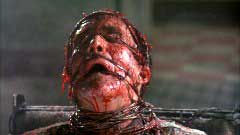 More
interesting (and concise) than the commentary is the retrospective featurette
“Hard Time” (37:56) featuring the participation of Harlin, producer
Yablans, executive producer Band, writer Joyner, actor Everett, production designer
Phillip Duffin (PHANTASM II), production assistant Patrick Denver (THE VIDEO
DEAD), stunt coordinator Hodder, and effects artist Buechler. Much of what Harlin
says here you will have already heard in the commentary, but the other participants
expand on his comments and provide some of their own anecdotes and factoids.
More
interesting (and concise) than the commentary is the retrospective featurette
“Hard Time” (37:56) featuring the participation of Harlin, producer
Yablans, executive producer Band, writer Joyner, actor Everett, production designer
Phillip Duffin (PHANTASM II), production assistant Patrick Denver (THE VIDEO
DEAD), stunt coordinator Hodder, and effects artist Buechler. Much of what Harlin
says here you will have already heard in the commentary, but the other participants
expand on his comments and provide some of their own anecdotes and factoids.

Yablans tries to talk up the real-life spookiness of the location (which was Wyoming’s oldest prison and had just been shut down when Yablans sent out inquiries for a gothic-looking abandoned prison), and reveals that real inmate Little came to his attention because he possessed a SAG card (having worked as a stuntman before imprisonment). Band says he was hands-off for this film – likely focusing on the other Empire productions being shot in Rome at the same time – but it was one of his pre-made posters that inspired Joyner (not the final poster was the more familiar skull artwork which is included on the reverse of Shout! Factory’s newly-commissioned artwork). Joyner mentions that one of the actors they had in mind before auditioning Mortensen was Thom Matthews (RETURN OF THE LIVING DEAD) and emphasizes Harlin’s participation in the rewrites. Duffin recalls that much of his work included trying to make the prison look more derelict and building a front gate (he claims it took the contracted workers a month and a half to get through the outer wall). Buechler attributes Harlin’s extensive storyboards to helping him realize the death scenes (a clearer view of one of the corpses than seen in the film is provided in the form of a make-up test still), while Hodder describes some of his suggestions to how to augment Buechler’s make-up job for the climax. Richard Band describes some of the scoring techniques he and Christopher Stone (who handled the electronic parts of the score) utilized in the film that are much more commonplace today.
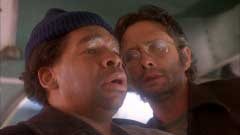 Two
trailers for the film are included: one from the US (1:28) and one from Germany
(1:25) where it seems to have been popular enough to have had the earliest DVD
release. Both seem to have the same narration and dialogue snippets (dubbed
in the German version with the exception of the narrator’s recitation
of the title at the end), but the montage of much of the same footage is edited
differently. There are three also still galleries including production stills,
posters – including a mock-up using Band’s original artwork –
and lobby cards, and three photographs of the Wyoming State Penitentiary as
it looks today (it now functions as a museum). The film’s 108-page first
draft screenplay – under the “Horror in the Big House” title
– is also included as a DVD-ROM extra (in .pdf format). The ending in
the film seems rushed and lazy compared to the one in the script, which also
includes a coda also left out of the finished film. (Eric
Cotenas)
Two
trailers for the film are included: one from the US (1:28) and one from Germany
(1:25) where it seems to have been popular enough to have had the earliest DVD
release. Both seem to have the same narration and dialogue snippets (dubbed
in the German version with the exception of the narrator’s recitation
of the title at the end), but the montage of much of the same footage is edited
differently. There are three also still galleries including production stills,
posters – including a mock-up using Band’s original artwork –
and lobby cards, and three photographs of the Wyoming State Penitentiary as
it looks today (it now functions as a museum). The film’s 108-page first
draft screenplay – under the “Horror in the Big House” title
– is also included as a DVD-ROM extra (in .pdf format). The ending in
the film seems rushed and lazy compared to the one in the script, which also
includes a coda also left out of the finished film. (Eric
Cotenas)